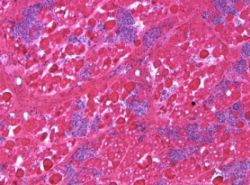 |
| In Duchenne muscular dystrophy, muscle structure is severely damaged. Muscle cell death (rounded cells) and muscle inflammation (blue staining) is abundant.--Courtesy of University of Missouri |
Gene therapy for Duchenne muscular dystrophy took a huge leap closer to the clinic this week. Researchers at the University of Missouri finally succeeded in delivering a gene for microdystrophin--a shortened version of the missing protein dystrophin--in dogs. This is the first time that gene therapy has worked in a large animal model of Duchenne muscular dystrophy, and it could pave the way to a clinical trial.
Dystrophin is a very large gene, and has to be cut down to size to fit in a gene therapy vector, resulting in microdystrophin with only around 30% of the coding sequence of the original protein.
While previous mouse studies of a microdystrophin gene therapy have been successful, the positive signs haven't transferred over in dogs. Dog studies are better at predicting the outcome in humans than mouse studies are, so the researchers set out for more testing in hopes of better results.
The team created a new trimmed form of the dystrophin gene, adding in a section previously deleted, and found that the new version of the gene therapy cut levels of inflammation, reduced muscle fibrosis and improved muscle strength. The research was published in Molecular Therapy.
"We still have a lot of work to do, but we now know that our gene therapy strategy works in large mammals; this is a quantum leap forward in fighting this disease. Our next step is to test our strategy in a large group of muscles in the dogs, and then, eventually, see if 'whole body therapy' will work in the dogs. We are still a long way off before we will have a human treatment, but with this finding, I do see a light at the end of this tunnel," said Dongsheng Duan at the University of Missouri's School of Medicine.
In muscular dystrophy, the loss of dystrophin means that muscle is replaced by fatty, bony or fibrous tissue and begins to degenerate. Duchenne muscular dystrophy is the most common form of the disease and is more common in boys. While there are treatments to help with the symptoms, and these improve quality of life and help people to live longer, there are no disease-modifying therapeutics, making this an area of significantly unmet medical need.
- read the press release
- see the abstract